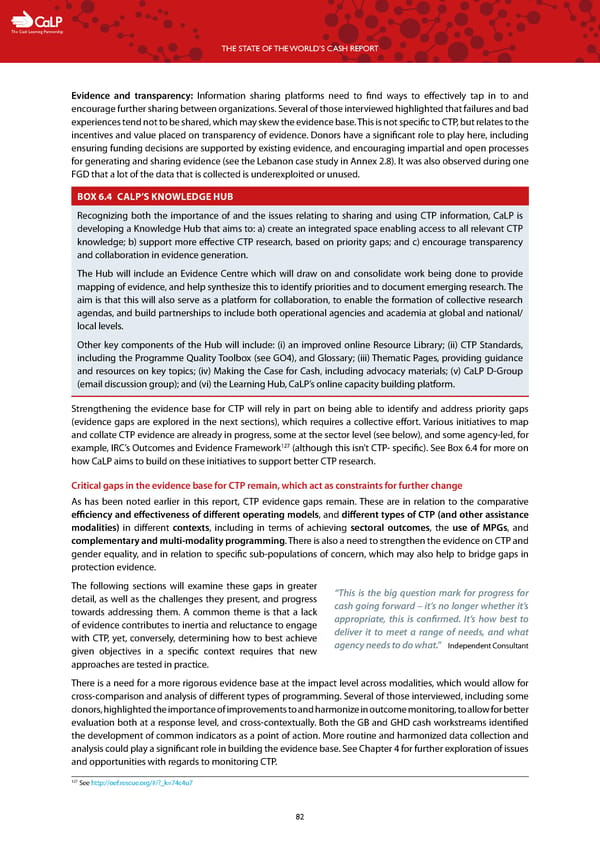C The Cash Learning Partnership THE STATE OF THE WORLD’S CASH REPORT Evidence and transparency: Information sharing platforms need to find ways to effectively tap in to and encourage further sharing between organizations. Several of those interviewed highlighted that failures and bad experiences tend not to be shared, which may skew the evidence base. This is not specific to CTP, but relates to the incentives and value placed on transparency of evidence. Donors have a significant role to play here, including ensuring funding decisions are supported by existing evidence, and encouraging impartial and open processes for generating and sharing evidence (see the Lebanon case study in Annex 2.8). It was also observed during one FGD that a lot of the data that is collected is underexploited or unused. BOX 6.4 CALP’S KNOWLEDGE HUB Recognizing both the importance of and the issues relating to sharing and using CTP information, CaLP is developing a Knowledge Hub that aims to: a) create an integrated space enabling access to all relevant CTP knowledge; b) support more effective CTP research, based on priority gaps; and c) encourage transparency and collaboration in evidence generation. The Hub will include an Evidence Centre which will draw on and consolidate work being done to provide mapping of evidence, and help synthesize this to identify priorities and to document emerging research. The aim is that this will also serve as a platform for collaboration, to enable the formation of collective research agendas, and build partnerships to include both operational agencies and academia at global and national/ local levels. Other key components of the Hub will include: (i) an improved online Resource Library; (ii) CTP Standards, including the Programme Quality Toolbox (see GO4), and Glossary; (iii) Thematic Pages, providing guidance and resources on key topics; (iv) Making the Case for Cash, including advocacy materials; (v) CaLP D-Group (email discussion group); and (vi) the Learning Hub, CaLP’s online capacity building platform. Strengthening the evidence base for CTP will rely in part on being able to identify and address priority gaps (evidence gaps are explored in the next sections), which requires a collective effort. Various initiatives to map and collate CTP evidence are already in progress, some at the sector level (see below), and some agency-led, for 127 example, IRC’s Outcomes and Evidence Framework (although this isn’t CTP- specific). See Box 6.4 for more on how CaLP aims to build on these initiatives to support better CTP research. Critical gaps in the evidence base for CTP remain, which act as constraints for further change As has been noted earlier in this report, CTP evidence gaps remain. These are in relation to the comparative efficiency and effectiveness of different operating models, and different types of CTP (and other assistance modalities) in different contexts, including in terms of achieving sectoral outcomes, the use of MPGs, and complementary and multi-modality programming. There is also a need to strengthen the evidence on CTP and gender equality, and in relation to specific sub-populations of concern, which may also help to bridge gaps in protection evidence. The following sections will examine these gaps in greater “This is the big question mark for progress for detail, as well as the challenges they present, and progress cash going forward – it’s no longer whether it’s towards addressing them. A common theme is that a lack appropriate, this is confirmed. It’s how best to of evidence contributes to inertia and reluctance to engage deliver it to meet a range of needs, and what with CTP, yet, conversely, determining how to best achieve agency needs to do what.” Independent Consultant given objectives in a specific context requires that new approaches are tested in practice. There is a need for a more rigorous evidence base at the impact level across modalities, which would allow for cross-comparison and analysis of different types of programming. Several of those interviewed, including some donors, highlighted the importance of improvements to and harmonize in outcome monitoring, to allow for better evaluation both at a response level, and cross-contextually. Both the GB and GHD cash workstreams identified the development of common indicators as a point of action. More routine and harmonized data collection and analysis could play a significant role in building the evidence base. See Chapter 4 for further exploration of issues and opportunities with regards to monitoring CTP. 127 See http://oef.rescue.org/#/?_k=74c4u7 82
 The State of the World's Cash | Full Report Page 83 Page 85
The State of the World's Cash | Full Report Page 83 Page 85